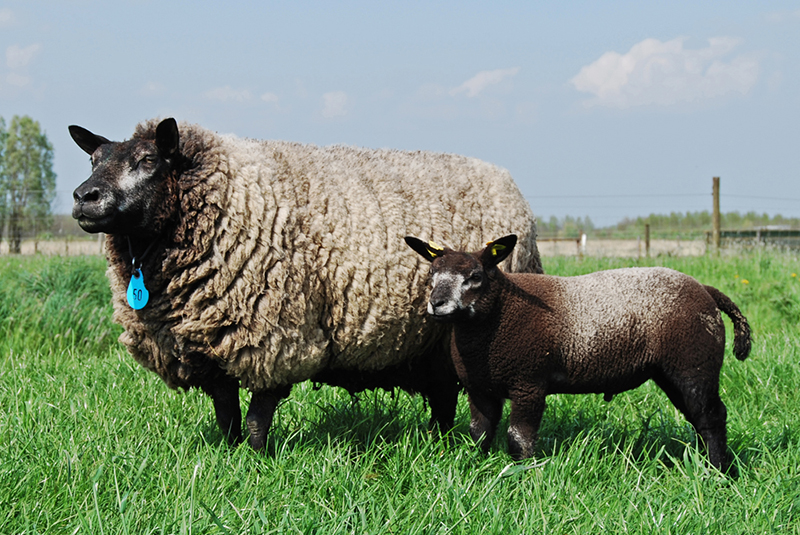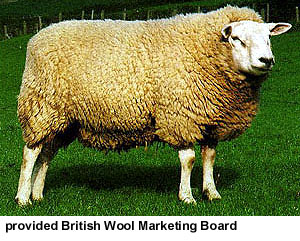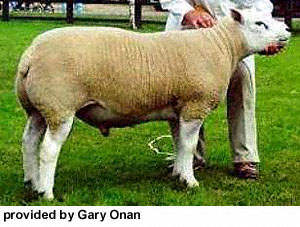Texel Sheep
 Also Known By: Texelaar, Texelse, Improved Texel, Verbeterde Texelse
Also Known By: Texelaar, Texelse, Improved Texel, Verbeterde Texelse
The Texel originated on the Isle of Texel off the coast of The Netherlands early in the nineteenth century. The original Old Texel was probably a short-tailed variety of sheep. Limited importations of Lincoln and Leicester Longwool were crossed with this stock during the mid-1800’s. The characteristics of the breed were established early on through a series of local showing competitions on the island. The emphasis was on a sheep that would produce heavily muscled lambs of superior eating quality. Since the primary market for these lambs was Continental Europe where excess fat on meat cuts has always been unpopular, significant effort was also made to produce a sheep that had a low propensity for fat deposition.
The first Texels in the United States were imported by the Meat Animal Research Center at Clay Center, NE in 1985. After a five-year quarantine, some were released for purchase by private individuals in 1990 and subsequent years. Private importations have since been made by a handful of breeders in the United States.
 The Texel breed today is a white-faced breed with no wool on the head or legs. The
breed is characterized by a distinctive short, wide face with a black nose and widely
placed, short ears with a nearly horizontal carriage. These sheep also have black
hooves. The wool is of medium grade (46-56’s) with no black fibers. Mature animals
shear fleece weights of 3.5-5.5 kg.
The Texel breed today is a white-faced breed with no wool on the head or legs. The
breed is characterized by a distinctive short, wide face with a black nose and widely
placed, short ears with a nearly horizontal carriage. These sheep also have black
hooves. The wool is of medium grade (46-56’s) with no black fibers. Mature animals
shear fleece weights of 3.5-5.5 kg.
The most outstanding feature of the Texel breed, however, is its remarkable muscle development and leanness. Research results from Clay Center and the University of Wisconsin indicate that Texel-sired lambs typically have a 6-10% advantage in loin-eye area when compared to American black-face-sired lambs. (In fact, many Texel breeders routinely scan loin-eyes as a selection tool and are finding 4+ square inches to be quite common with 5 square inch eyes appearing fairly often.) Texel-sired lambs also show an advantage of one full leg score in these comparisons and less total carcass fat — especially seam fat. This is significant in that seam fat is much harder to trim manually during fabrication than are subcutaneous and internal fat deposits. Curiously, even though Texel lambs in these trials grew slightly slower than the black-faced lambs, their feed efficiency was better. In a trial comparing Texel ram lambs to black-faced ram lambs, the Texels required about 15 lbs less feed to produce 60 lbs of gain.
The Texel has become the dominant terminal-sire breed in Europe. It is currently nearly equal to the Suffolk in market share in the United Kingdom and gaining fast. The breed is also gaining in popularity in Australia and New Zealand as their production systems have shifted away from primary emphasis on wool to greater emphasis on lamb meat production. The breed clearly offers an opportunity for the North American sheep industry to improve the carcass merit of its product as well.
Breed Associations and Registries
Belgium
 Association namuroise des Eleveurs de Moutons à Viande
Association namuroise des Eleveurs de Moutons à Viande
Secretary: Christiane Perot
Phone/fax 0032-(0)85613221
Email: perot.christiane@swing.be
Texel/Beltex: Philippe DEJARDIN
Phone: 0032-(0)82677358
Fax: 0032-(0)84387114
Email: philippe.dejardin8@yucom
Netherlands
Nederlandse Texelse Schapenstamboek (NTS)
Mauritsstraat 8
Varseveld
United Kingdom
The British Texel Sheep Society Ltd
National Agricultural Centre
Stoneleigh Park
Kenilworth
Warwickshire
CV8 2LG
United Kingdom
Tel: 0044 (0)2476 696629
Fax: 0044 (0)2476 696472
CEO and Company Secretary: Mr S J McLean
Northern Ireland Texel Sheepbreeders' Club
Secretary - Brian King
Laymore
197
Old Ballymoney Road
Ballymena
Co. Antrim
UK Tel/fax: (44) 01266 653229
United States
Texel Sheep Breeders Society
Robert Stonerock, Treasurer
8955 Black Run Road
Nashport, Ohio 43830
(406) 436-2286
strikehold504inf@MSN.com
References
British Sheep and Wool, British Wool Marketing Board, Oak Mills, Station Rd., Clayton, Bradford. 112 pp.
Mason, I.L. 1996. A World Dictionary of Livestock Breeds, Types and Varieties. Fourth Edition. C.A.B International. 273 pp.
Dr. Gary Onan, Animal & Food Science Department, University of Wisconsin - River Falls, River Falls WI
